25 Popular Types Of Dracaena Plants Indoors And Outdoors
Written by Ivy
Dec 28 2022
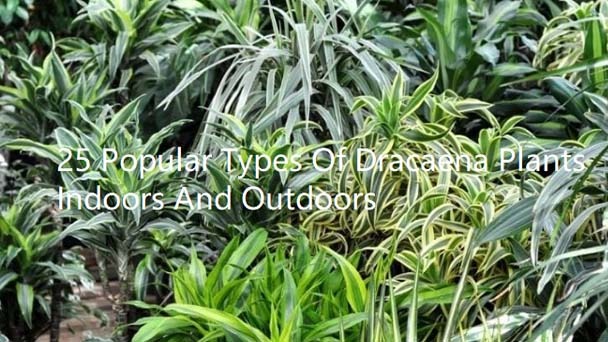
Numerous plant species that are frequently grown indoors belong to the genus Dracaena. To help you choose the best Dracaena species for your home, I'll introduce you to 25 commonly found species as you read on.
How to Identify a Dracaena Plant
There are numerous species in this diverse plant family that are popular picks for both indoor and outdoor gardens. But how can you tell which dracaena plant would be best for you and your home when there are so many different varieties available?
The leaves are one of the most reliable signs that a plant is a Dracaena variety. The leaves of dracaena plants typically grow longer and occasionally droop, and they are typically tightly clustered. For the most part, but not all Dracaena varieties, this is true.
1. Dragon Tree ‘Colorama' (Dracaena Marginata ‘Colorama')
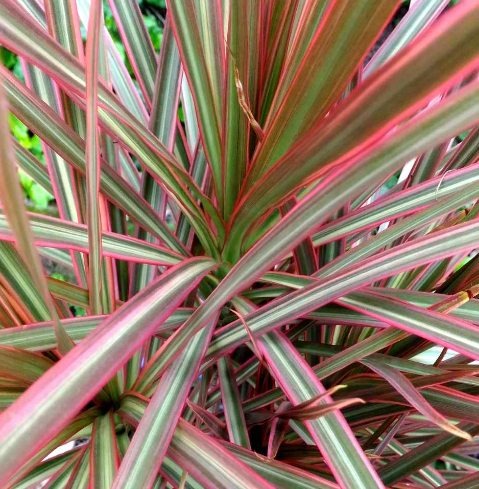
- Height: 5-6 ft.
- Light: Bright indirect or filtered sunlight
This dragon tree has pink foliage with white and green stripes. To maintain its distinctive colors, it needs extremely bright but indirect light.
2. Dragon Tree ‘Magenta' (Dracaena Marginata ‘Magenta')
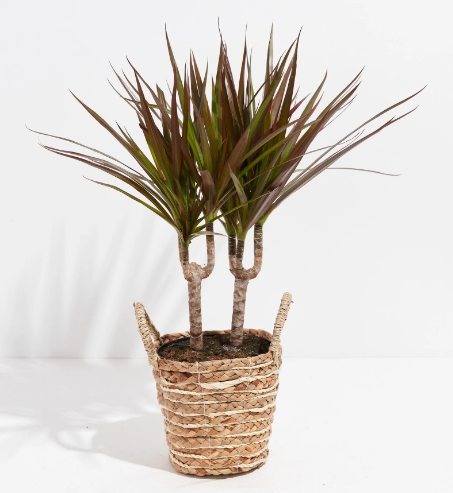
- Height: 6 ft.
- Light: Bright indirect or filtered sunlight
The green leaves with magenta-red edges on this palm tree resembler are its most striking feature. Although it can reach a height of 6 feet or less when grown inside, it can reach 15 to 20 feet tall in its natural habitat when grown as a houseplant. It is hardy and low-maintenance.
3. Dragon Tree ‘Tarzan' (Dracaena Marginata ‘Tarzan')
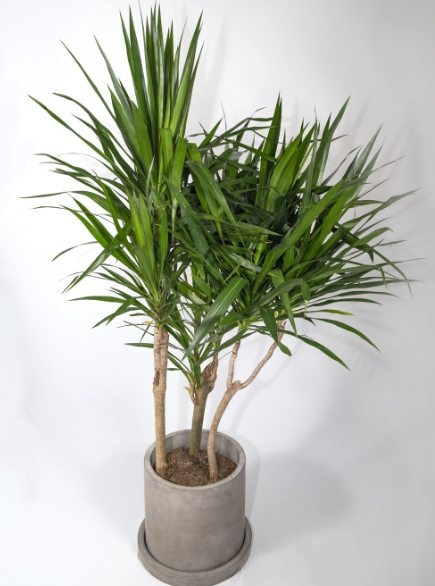
- Height: 6 ft.
- Light: Bright indirect or filtered sunlight
The harder, wider, slightly thicker, and spikier leaves, as well as the shape of the leaves at the top of each stem, set this cultivar apart from other dragon trees.
4. Dragon Tree ‘Tricolor' (Dracaena Marginata ‘Tricolor')
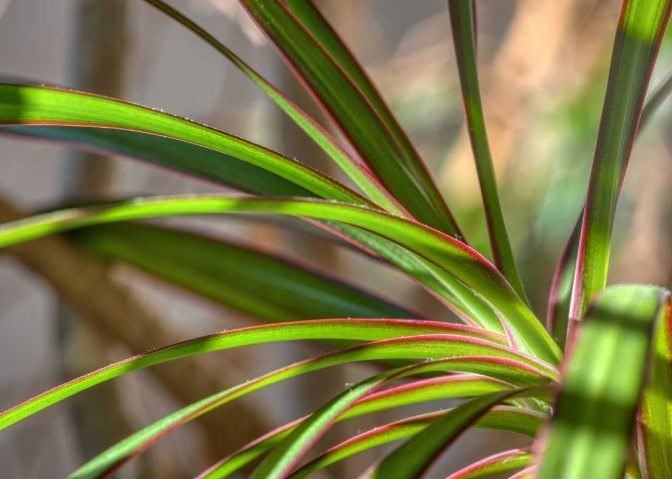
- Height: 6 ft.
- Light: Bright indirect or filtered sunlight
The richly colored leaves of this dragon tree variety are banded with white edges.
5. Dracaena Fragrans ‘Cintho'
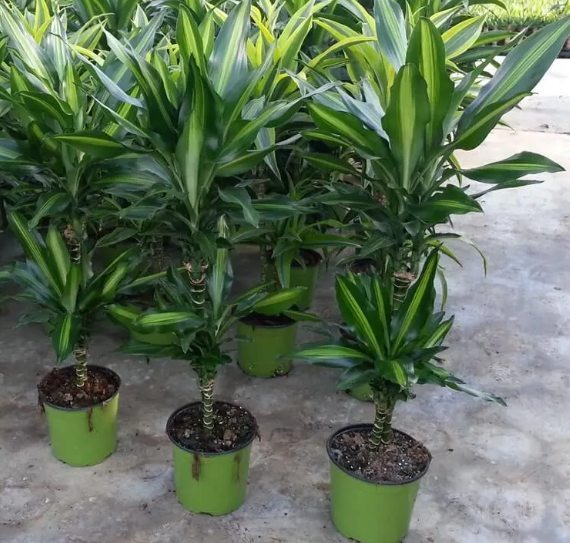
- Height: 3 ft.
- Light: Bright indirect or filtered sunlight
Broad leaves of the Corn plant (Dracaena Fragrans) with distinct emerald and lime-green stripes can be found on this vividly colored, short dracaena variety. It resembles a miniature tree because it grows several stems in a single pot.
6. Dracaena Fragrans ‘Dorado'
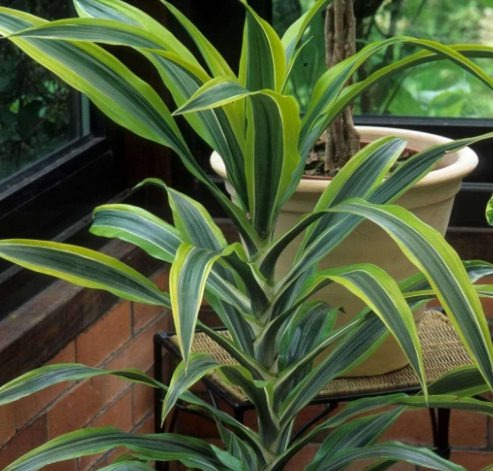
- Height: 4-5 ft.
- Light: Bright indirect or filtered sunlight
This cultivar has thick, lime-green leaves with a dark green border that curl downward. Around the stem, the lavish broad foliage develops in a compact, dense way.
7. Dracaena Fragrans ‘Hawaiian Sunshine'
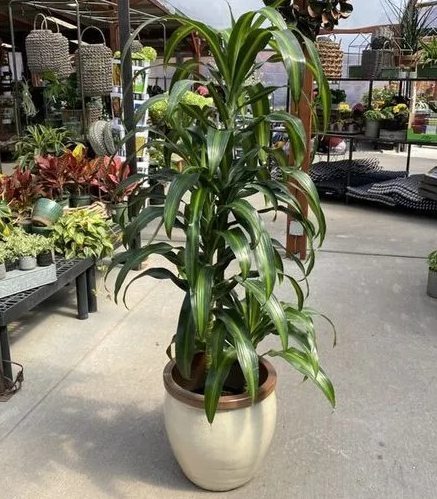
- Height: 3-6
- Light: Bright indirect or filtered sunlight
This compact variety with an upright growth habit is a good option for small indoor spaces. Stripes of light and dark green are present on the attractive glossy foliage. During the summer, you can move this plant outside as long as you put the container in a partially to completely shaded area.
8. Dracaena Janet Craig (Dracaena Fragrans ‘Compacta')
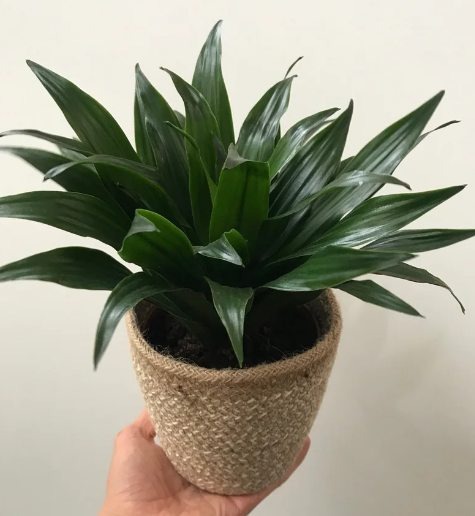
- Height: 3-6 ft.
- Light: Bright indirect or filtered sunlight
This cultivar of the corn plant, another one of the most well-liked dracaena varieties, is regarded as a workhorse because it can endure low light levels. Its glossy, substantial, broad, dark green leaves have wavy margins.
9. Dracaena Fragrans ‘Lemon Lime'
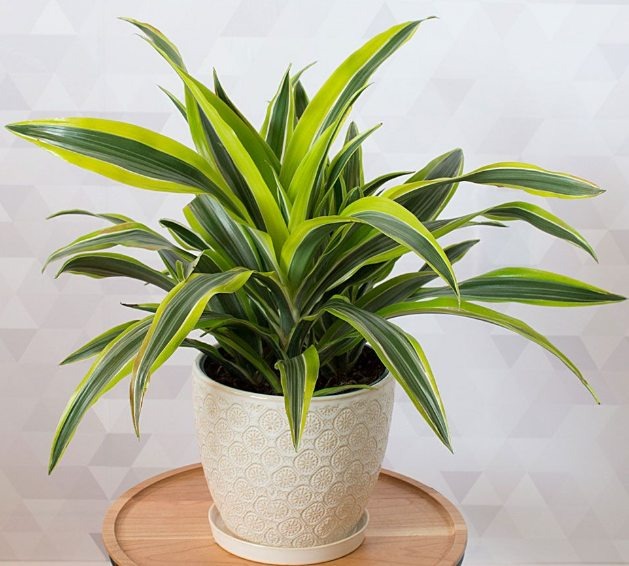
- Height: 5-10 ft.
- Light: Bright indirect or filtered sunlight
A strikingly colored cultivar with sword-shaped leaves that have cream, greenish-yellow, and lime-green stripes at the top of the stem that resembles a tree.
10. Dracaena Fragrans ‘Limelight'
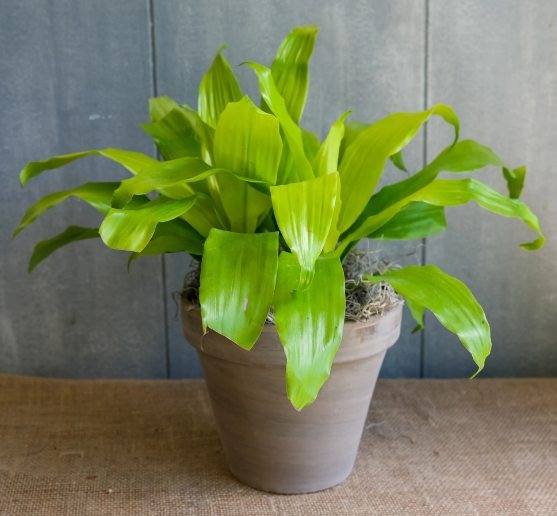
- Height: 6 ft.
- Light: Bright indirect or filtered sunlight
This cultivar matures slowly, changing from glossy yellow-green to a lighter lime-green.
11. Mass Cane (Dracaena Fragrans ‘Massangeana')
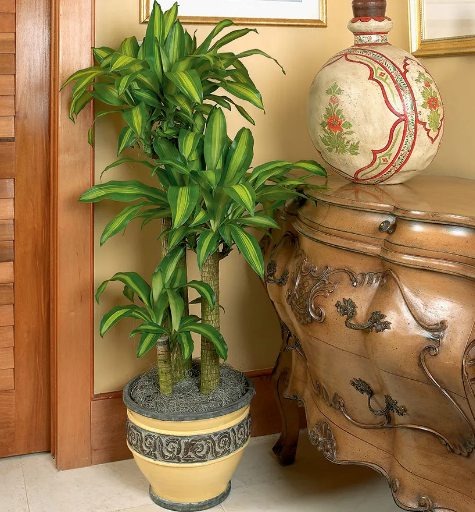
- Height: 6 ft.
- Light: Bright indirect or filtered sunlight
The dracaena species known as the corn plant (D. fragrans) got its name from how much its leaves resemble corn stalk leaves in terms of both appearance and texture. One of the most widespread cultivars, mass cane has a woodier stem than the species as a whole. Its leaves are striped down the middle in a yellowish lime green color.
12. Dracaena Warnock (Dracaena Fragrans ‘Warneckii')
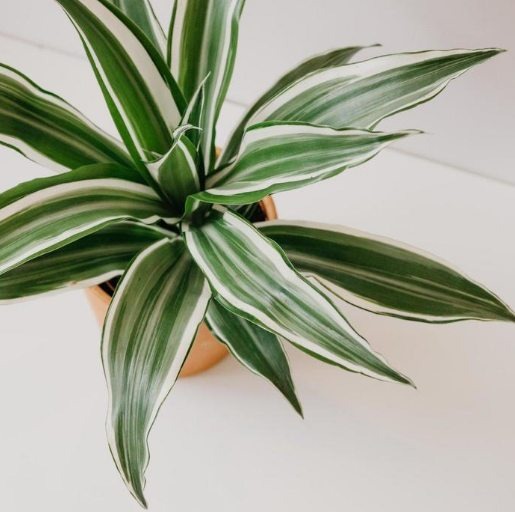
- Height: 5 ft.
- Light: Bright indirect sunlight
This variety is another popular houseplant because of its bushy, upright growth habit surrounding a central trunk and its grey-green leaves with distinct white or green stripes. The plant is also known as striped dracaena, but this common name is misleading because many other dracaena varieties also have striped foliage.
13. Dracaena Fragrans ‘White Jewel'
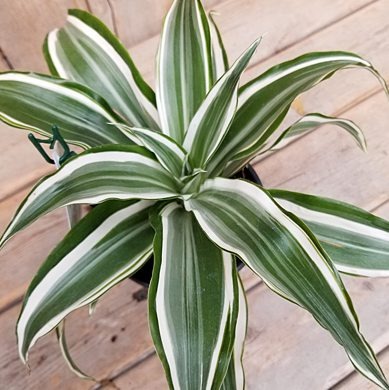
- Height: 4-6 ft.
- Light: Bright indirect or filtered sunlight
This variety may be the ideal dracaena for illuminating a particular area of your home. The glossy, dark green leaves have traces of light green and white stripes.
14. Song of India (Dracaena Reflexa)
_39_11zon.webp)
- Height: 3-6 ft.
- Light: Bright indirect or filtered sunlight
With multiple stems growing in a single container, this tropical shrub makes a simple houseplant. A band of gold surrounds the leaves of Song of India (Dracaena Reflexa).
15. Snake Plant (Dracaena Trifasciata)
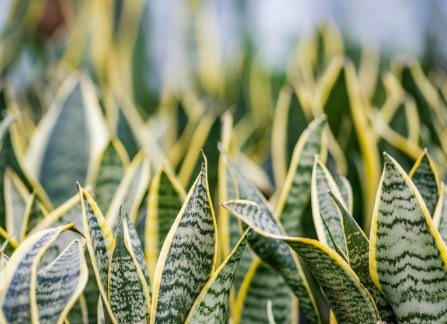
- Height: 6 in.-8 ft.
- Light: Bright indirect or filtered sunlight
There is a good reason why Dracaena Trifasciata is one of the most well-liked indoor plants. This slow grower is tough and simple to care for, even for novice plant parents, thanks to its stiff, sword-like leaves. It is known for being unbreakable.
16. Lucky Bamboo (Dracaena Sanderiana)
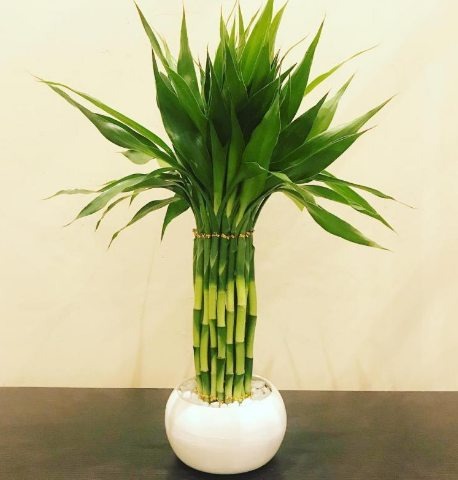
- Height: 3-4 ft.
- Light: Bright indirect or filtered sunlight
Lucky Bamboo is bamboo in name only, also referred to as Chinese water bamboo. Water or a pot with gravel and water can both support its growth.
17. Ribbon Dracaena (Dracaena Sanderiana ‘Silver Ribbon')
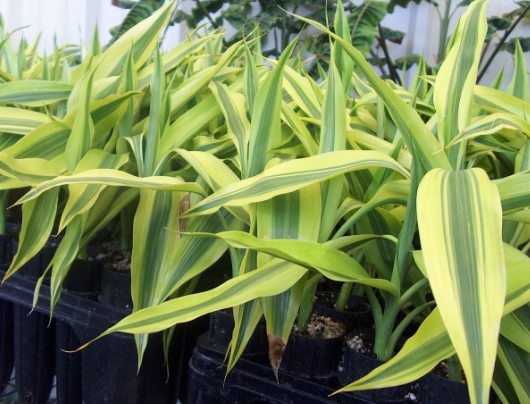
- Height: 4-5 ft.
- Light: Bright indirect or filtered sunlight
The leaves of this lucky bamboo cultivar, which is also variegated, are slightly twisted and have vibrant stripes.
18. Dracaena Sanderiana ‘White Stripe'
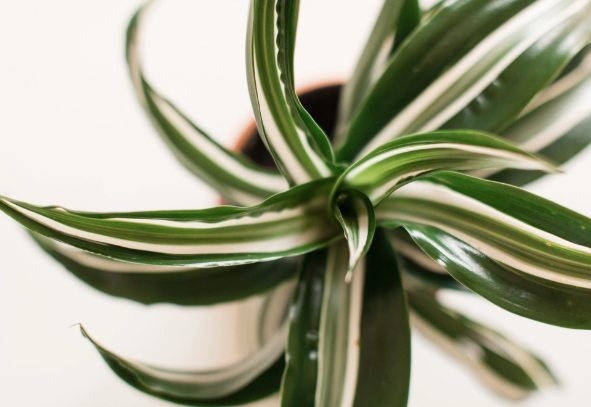
- Height: 3-4ft.
- Light: Bright, indirect sunlight
This well-liked variety of lucky bamboo has deep green variegated leaves with a creamy white edge.
19. Gold Dust Dracaena (Dracaena Surculosa ‘Florida Beauty')
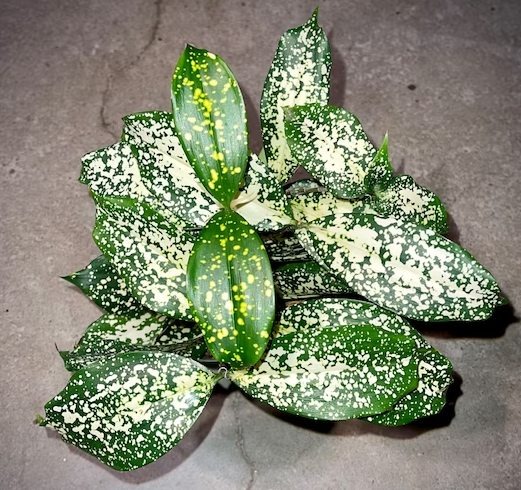
- Height: 2 ft.
- Light: Bright indirect or filtered sunlight
The common name of this cultivar comes from the distinctive bright, creamy yellow spots that appear to be gold dust on the broad leaves.
20. Dracaena Surculosa ‘Milky Way'
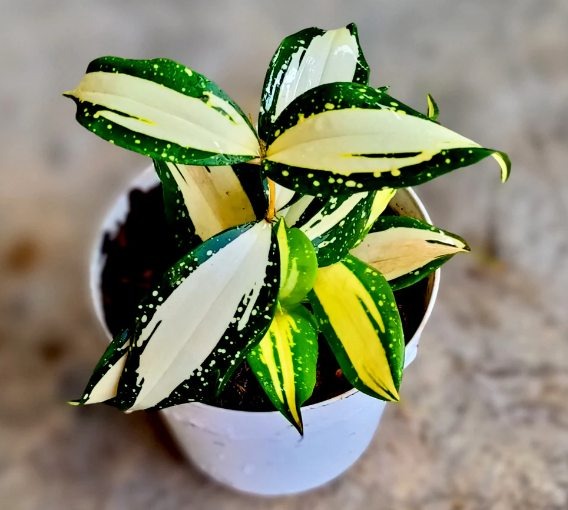
- Height: 1 ft.
- Light: Bright indirect or filtered sunlight
Thin, arching stems and clumping growth are characteristics of this rare dracaena. The name of this variety comes from the long, white band in the center of the broad, elliptic leaves.
21. Zebra Plant (Dracaena Goldieana)
_46_11zon.webp)
- Height: 10 ft.
- Light: Full sun, partial shade outdoors; bright, indirect sunlight indoors
USDA Hardiness Zones: 11-13
Another uncommon dracaena with zebra stripes that is indigenous to tropical West Africa. Zebra Plant has leaves that are grey with dark green bands. The plant can be grown indoors or outdoors, though it won't grow as tall inside.
22. Dracaena Tree (Dracaena Arborea)
_47_11zon.webp)
- Height: 15 ft.
- Light: Full sun
- USDA Hardiness Zones: 10-11
The slender dragon tree is another name for this particular tree. And in fact, it's easy to mistake it for a palm tree due to its woody, thin, upright trunk and long, lance-shaped, dark green leaves. Tropical West Africa is the tree's original habitat. It is usually grown outdoors due to its size.
23. Spikes (Dracaena Indivisa ‘Proven Accents')
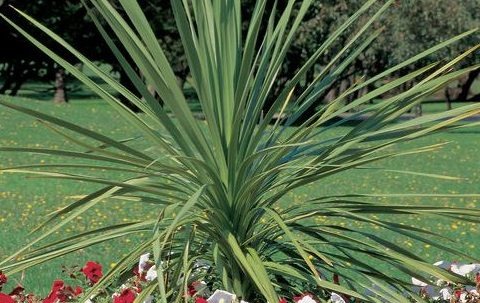
- Height: 2-3 ft.
- Light: Full sun, partial shade
- USDA Hardiness Zones: 7-11
Only one species of dracaena on this list is an annual. Heat-resistant and low-maintenance outdoor plants for gardens and patios include the trademarked cultivar "Proven Accents." It is raised for its foliage, which has long, sword-like leaves that add contrast to a flower bed. It can be grown in containers as well.
24. Red Blood Dragon Tree (Dracaena Draco)
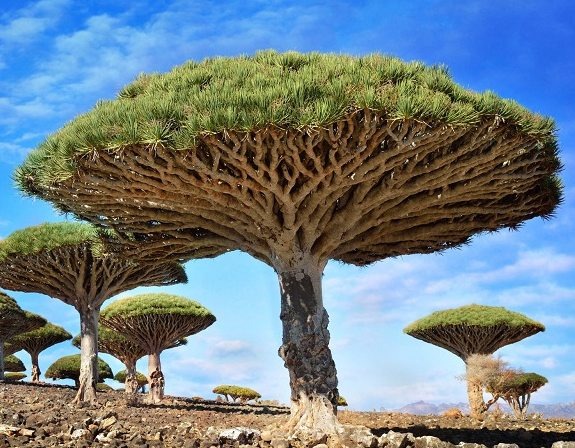
- Height: 15 ft.
- Light: Full sun, partial shade
- USDA Hardiness Zones: 9-12
This evergreen tree, which has leaves in the shape of a sword, is best grown outdoors due to its height, but it can also be grown indoors, though it won't get as tall. Native to the Canary Islands and northwest coastal Africa, the tree. The sap of the tree has a color resembling blood, hence the name.
25. Socotra Dragon Tree (Dracaena Cinnabari)
_50_11zon.webp)
- Height: 33 ft.
- Light: Full sun
- USDA Hardiness Zones: 10-11
This impressive evergreen tree resembles a giant mushroom with its dense crown. They look like gills because only the top leaves are green and the branches below are bare. The location must provide the tree with plenty of direct, all-day sunlight and a warm, tropical climate. Its native territory is the Socotra Archipelago, which is located close to the Gulf of Aden in the northwest Indian Ocean.
How to Grow & Care for Dracaena
Every variety of Dracaena plant is simple to maintain. You can keep your plant healthy and looking its best with just a little bit of knowledge. You can find all the information you need on growing dracaena plants here, along with advice on fertilizing, lighting, and watering.
Height & Spread
The fact that Dracaena plants are available in a range of sizes is one of the factors contributing to their popularity. There is undoubtedly a Dracaena plant out there for you, whether you're looking for a small one to liven up your desk or a large one to fill up a vacant corner.
Soil
Although dracaena plants are not picky about their soil, they do prefer well-drained, sandy soil that is rich in organic matter. If your soil is heavy or clay-based, you can improve drainage by adding sand or grit to the planting hole. Additionally salt-tolerant, these plants are a wise choice for coastal gardens.
Position
The ideal environment for all Dracaena plants is one with plenty of indirect sunlight. This means that the best location for your Dracaena plant is in a room with lots of natural light, but make sure the plant doesn't receive too much direct sunlight.
Temperature & Humidity
The fact that dracaena plants can withstand a wide range of temperatures is one of their best qualities. They can tolerate cooler temperatures down to 50 degrees Fahrenheit and are comfortable in rooms that are maintained at a temperature of about 70 degrees. They are therefore perfect for settings like homes and workplaces where the temperature varies or is not constant.
Watering
It's crucial to properly water your dracaena. You'll need to strike a balance because either too much or too little water can be bad for the plant. It is best to feel the soil to gauge how much water your plant needs; if it feels dry, water now. Avoid overwatering and water the plant just enough to evenly moisten the soil. Never let the plant sit in water; let any extra water drain away.
Fertilizing
Maintaining the health and growth of your Dracaena plant requires fertilization. Apply a multipurpose fertilizer every two to three months. Make sure to adhere to the instructions on the fertilizer package. Your plant may suffer if you fertilize it too much. Using a plant food will help you easily avoid overfertilizing and underfertilizing.
Flowering
You should look for the Dracaena Fragrans or the Dracaena Deremensis if you want a Dracaena plant that blooms so you can enjoy its lovely flowers. Other varieties may flower, but these are the most prevalent, and they typically only do so after the plant has reached maturity.
Repotting
To ensure that your Dracaena plant thrives, you may need to occasionally repot it. Here are some tips on how to repot a Dracaena plant:
- Select a pot that is only marginally bigger than the current one. This will allow the roots to expand unhindered.
- Make sure to use new potting soil and to include some additional drainage material, like gravel or perlite.
- When handling the roots, exercise caution because they are weak and easily harmed.
- Water thoroughly after gently pressing the potting mixture against the roots.
Your Dracaena plant will flourish for many years to come with just a little bit of care!
Pruning
Your plant will grow more quickly and continue to look full and healthy if you prune it. It's a good way to manage your plant's size, too.
Simply trim any lanky or overgrown stems to the desired length to prune your Dracaena. For this, use a knife or a pair of razor-sharp shears. For your plant to heal quickly, make sure to make clean, straight cuts.
Dracaenas can be pruned as frequently as once per month if necessary. To avoid harming the plant, just be careful not to overdo it. Pruning less frequently and going conservatively is a good idea when in doubt.
How to Propagate Dracaena Plants
Stem cuttings are the most effective method of Dracaena propagation. In order to ensure that the cutting has at least two nodes, you should cut a section of material that is about 6 inches long. The cutting can then be placed in water or moist soil while you wait for it to take root. After it has rooted, you can move it into a separate pot.
Water
Due to the fact that it is one of the simplest methods, propagating plants in water is very popular. Just cut a piece off your plant and put it in a vase with some fresh water. To stop diseases from growing in the water, make sure to change it every few days.
To help the cutting root more quickly, use a propagation promoter and rooting hormone!
Air Layering
This plant can also be multiplied by air layering. By taking a cutting from the plant and leaving it attached to the parent plant while it develops roots, the process is known as air layering.
Find a healthy stem on the plant that is at least a few inches long before beginning to air layer a Dracaena marginata. Cut a notch into the stem that is 1 to 2 inches long, being careful not to cut all the way through.
Sphagnum moss that has been dampened should be inserted into the notch, and the area should then be completely covered in plastic wrap. Make sure the plastic wrap is tightly fastened to prevent the moss from escaping.
To keep the moss moist, place the wrapped portion in a warm, humid environment and mist it frequently. The moss should start to form roots in a couple of weeks. Cut the stem below the plastic wrap once the roots are well-established, then pot your new plant!
Common Problems With Dracaena Plants
Despite the fact that dracaenas require little maintenance typically, they can experience a few problems that could harm your plant. Here are a few of the most typical issues with Dracaena.
Leaning
Leaning can become a serious issue when there are many larger indoor plants. Your plant may be leaning for a number of reasons, such as a pot that is too small to support the size of the plant, a pet that persistently tries to climb the plant, or a lack of light. If any of these problems, which are all fairly simple to fix, are the cause of the leaning in your plant, check it out.
Drooping
Too much sun, insufficient water, or even a deficiency in nutrients can all contribute to drooping. Try to identify the cause and make repairs if you see your Dracaena plant drooping.
Yellow Leaves
The dracaena plant may be receiving too much sunlight if you notice the leaves turning yellow. Despite the fact that dracaenas prefer bright, indirect light, too much direct light can scorch the leaves and make them turn yellow. Move your plant to a location with less sunlight if you think that might be the issue.
A lack of nutrients may also be indicated by yellow leaves. Because they consume a lot of food, dracaenas require regular fertilization—roughly once per month during the growing season. Its leaves will start to turn yellow if your plant is not receiving enough fertilizer. The best results come from using a fertilizer that is well-balanced and following the instructions on the package.
Yellow leaves can also indicate root rot. If not addressed, this is typically brought on by overwatering and could prove fatal to the plant. If the roots of your plant appear to be soft or mushy, it is time to take action. To avoid future issues, lessen how often you water and check that the pot has good drainage.
Brown Tips
If the tips of your Dracaena plant start to turn brown, that might mean the plant isn't getting enough water. Make sure to monitor the soil's moisture level and provide the appropriate amount of water. Regular fertilization is also important because it will keep the plant healthy and green.
Root Rot
Root rot is among Dracaena plants' most prevalent issues. Water in the plant's pot has accumulated, which is the cause of this. Root rot is probably the cause of your Dracaena's yellowing or dropping leaves. Make sure to water your Dracaena only when the soil feels dry to the touch to avoid this. Try repotting your plant in new, well-draining soil and treating it with our Root Supplement if you suspect root rot.
Scale
Due to their notoriously difficult nature to eradicate, scale insects can rank among the scariest insects to discover on your indoor plant. insecticides won't work on them, so your only option is either using neem oil or pruning off the branches they've called home. To kill them, drown them in soapy water. Depending on the severity of the infestation, additional treatments might be required.
Mealybugs
It is likely that mealybugs will eventually appear if you are growing dracaena indoors. Small, wingless insects called mealybugs eat the sap of plants. They frequently inhabit cracks and the undersides of leaves, and if unchecked, they can quickly infest dracaena plants. Mealybugs can infect plants with diseases and cause the yellowing and wilting of leaves.
Start by separating any plants that have been infected by mealybugs. Then, apply rubbing alcohol to the insects using a cotton swab or Q-tip. Neem oil or an insecticidal soap are other options. To stop the spread of mealybugs, you might need to remove the plant if the infestation is bad.
FAQ Types of Dracaena Plants
Is a Dragon Tree the Same as a Dracaena?
One of the numerous Dracaena species is the dragon tree. Dracaena Marginata is the name of the plant.
What Plants Look Like Dracaena?
The Yucca plant is one relatively well-known plant that resembles some Dracaena varieties. While some other plant families have a similar appearance to Dracaena plants, there is typically not much else in common with them.
How Often Do You Water a Dracaena Plant?
You should try to water most Dracaena plants thoroughly once every 7 to 10 days in the spring and summer and once every 14 to 21 days in the late fall and winter.
Do Dracaena Plants Purify Air?
Dracaena plants can purge your home's air of benzene, formaldehyde, trichloroethylene, xylene, toluene, and carbon dioxide, according to NASA's clean air study.
What's the Best Soil Mix for Dracaena Plants?
A coarse, well-draining all-purpose houseplant mix is the ideal soil mix for dracaena plants.
How Do I Revive Dracaena?
Overwatering or a lack of light are the two main causes of dracaena plant decline. If the soil base seems saturated, test it for moisture (using a probe or your fingers) and let it completely dry out. Make sure the plant is not exposed to any cold drafts and move it to a room with more light.
Latest Updated
- Benefits of Bugleweed - 7 Science-backed Health Benefits
- Bugleweed Dangers & Side Effects - Is It Poisonous?
- How to Plant Evergreen Trees - What You Should Know
- When to Plant Evergreens - Grow Guide for Evergreen Trees
- 12 Wonderful Evergreen Shrubs for Your Garden
- 12 Popular Evergreen Plants with Pictures for Beginners
- When And How To Prune A Lilac Bush Like a Pro
- How to Grow & Care for Lilac Vine (Hardenbergia Violacea)
- Japanese Lilac Tree (Syringa Reticulata) Care & Propagation Guide
- Shumard Oak Pros and Cons - What to Know
Popular Articles
- Winter maintenance of Antirrhinum Majus
- How to Grow Terminalia Mantaly Tree
- How to Grow and Care for Crossostephium Chinense
- How to grow Antirrhinum Majus in spring
- Peristeria Elata (Dove Orchid) Profile: Info & Care Guide
- Underwatered Snake Plant (Sansevieria Trifasciata) - Signs And How To Fix
- How to Care for Brazilian Jasmine Plant (Mandevilla Sanderi)
- How to Grow & Care for Graptopetalum Purple Delight in Summer
- Rosa Chinensis (China Rose): Plant Growing & Care Tips
- How to Care for Baby Sun Rose (Aptenia Cordifolia)